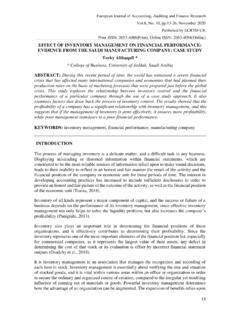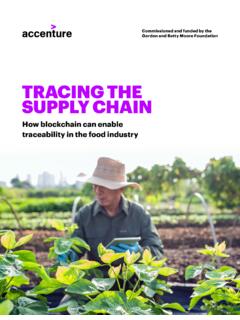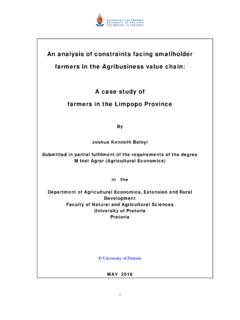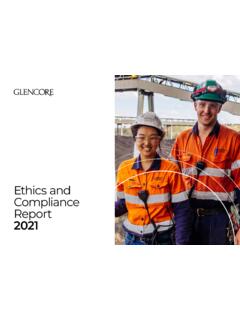Transcription of article HBR sustainability key driver - Bill Synnot and …
1 Why sustainability Is Now the Key driver of Innovation by Ram Nidumolu, Prahalad, and Rangaswami (Harvard Business Review, September 2009, pp 57-64) There s no alternative to sustainable development. Even so, many companies are convinced that the more environment-friendly they become, the more the effort will erode their competitiveness. They believe it will add to costs and will not deliver immediate financial benefits. Talk long enough to CEOs, particularly in the United States or Europe, and their concerns will pour out: Making our operations sustainable and developing green products places us at a disadvantage vis- -vis rivals in developing countries that don t face the same pressures. Suppliers can t provide green inputs or transparency; sustainable manufacturing will demand new equipment and processes; and customers will not pay more for eco-friendly products during a recession.
2 That s why most executives treat the need to become sustainable as a corporate social responsibility, divorced from business objectives. Not surprisingly, the fight to save the planet has turned into a pitched battle between governments and companies, between companies and consumer activists, and sometimes between consumer activists and governments. It resembles a three-legged race, in which you move forward with the two untied legs but the tied third leg holds you back. One solution, mooted by policy experts and environmental activists, is more and increasingly tougher regulation. They argue that voluntary action is unlikely to be enough. Another group suggests educating and organizing consumers so that they will force businesses to become sustainable. Although both legislation and education are necessary, they may not be able to solve the problem quickly or completely.
3 Executives behave as though they have to choose between the largely social benefits of developing sustainable products or processes and the financial costs of doing so. But that s simply not true. We ve been studying the sustainability initiatives of 30 large corporations for some time. Our research shows that sustainability is a mother lode of organizational and technological innovations that yield both bottom-line and top-line returns. Becoming environment-friendly lowers costs because companies end up reducing the inputs they use. In addition, the process generates additional revenues from better products or enables companies to create new Why sustainability is Now the Key driver of Innovation Harvard Business Review : Sept. 09 Page 2 businesses. In fact, because those are the goals of corporate innovation, we find that smart companies now treat sustainability as innovation s new frontier.
4 Indeed, the quest for sustainability is already starting to transform the competitive landscape, which will force companies to change the way they think about products, technologies, processes, and business models. The key to progress, particularly in times of economic crisis, is innovation. Just as some internet companies survived the bust in 2000 to challenge incumbents, so, too, will sustainable corporations emerge from today s recession to upset the status quo. By treating sustainability as a goal today, early movers will develop competencies that rivals will be hard-pressed to match. That competitive advantage will stand them in good stead, because sustainability will always be an integral part of development. It isn t going to be easy. Enterprises that have started the journey, our study shows, go through five distinct stages of change. They face different challenges at each stage and must develop new capabilities to tackle them, as we will show in the following pages.
5 Mapping the road ahead will save companies time and that could be critical, because the clock is ticking. Stage 1: Viewing Compliance as Opportunity The first steps companies must take on the long march to sustainability usually arise from the law. Compliance is complicated: Environmental regulations vary by country, by state or region, and even by city. (In 2007 San Francisco banned supermarkets from using plastic bags at checkout; San Diego still hasn t.) In addition to legal standards, enterprises feel pressured to abide by voluntary codes general ones, such as the Greenhouse Gas Protocol, and sector-specific ones, such as the Forest Stewardship Council code and the Electronic Product Environmental Assessment Tool that non-governmental agencies and industry groups have drawn up over the past two decades. These standards are more stringent than most countries laws, particularly when they apply to cross-border trade.
6 It s tempting to adhere to the lowest environmental standards for as long as possible. However, it s smarter to comply with the most stringent rules, and to do so before they are enforced. This yields substantial first-mover advantages in terms of fostering innovation. For example, automobile manufacturers in the United States take two or three years to develop a new car model. If GM, Ford, or Chrysler had embraced the California Air Resources Board s fuel consumption and emissions standards when they were first proposed, in 2002, it would be two or three design cycles ahead of its Why sustainability is Now the Key driver of Innovation Harvard Business Review : Sept. 09 Page 3 rivals today and poised to pull further ahead by 2016, when those guidelines will become the basis of law. Enterprises that focus on meeting emerging norms gain more time to experiment with materials, technologies, and processes.
7 For instance, in the early 1990s Hewlett-Packard realized that because lead is toxic, governments would one day ban lead solders. Over the following decade it experimented with alternatives, and by 2006 the company had created solders that are an amalgam of tin, silver, and copper, and even developed chemical agents to tackle the problems of oxidization and tarnishing during the soldering process. Thus HP was able to comply with the European Union s Restriction of Hazardous Substances Directive, which regulates the use of lead in electronics products, as soon as it took effect, in July 2006. Contrary to popular perceptions, conforming to the gold standard globally actually saves companies money. When they comply with the least stringent standards, enterprises must manage component sourcing, production, and logistics separately for each market, because rules differ by country.
8 However, HP, Cisco, and other companies that enforce a single norm at all their manufacturing facilities worldwide benefit from economies of scale and can optimize supply chain operations. The common norm must logically be the toughest. Companies can turn antagonistic regulators into allies by leading the way. For instance, HP has helped shape many environmental regulations in Europe, and it uses the resulting brownie points to advantage when necessary. In 2001 the European Union told hardware manufacturers that after January 2006 they could not use hexavalent chromium which increases the risk of cancer in anyone who comes in contact with it as an anticorrosion coating. Like its rivals, HP felt that the industry needed more time to develop an alternative. The company was able to persuade regulators to postpone the ban by one year so that it could complete trials on organic and trivalent chromium coatings.
9 This saved it money, and HP used the time to transfer the technology to more than one vendor. The vendors competed to supply the new coatings, which helped reduce HP s costs. Companies in the vanguard of compliance naturally spot business opportunities first. In 2002 HP learned that Europe s Waste Electrical and Electronic Equipment regulations would require hardware manufacturers to pay for the cost of recycling products in proportion to their sales. Calculating that the government-sponsored recycling arrangements were going to be expensive, HP teamed up with three electronics makers Sony, Braun, and Electrolux to create the private European Recycling Platform. In 2007 the platform, which works with more than 1,000 Why sustainability is Now the Key driver of Innovation Harvard Business Review : Sept. 09 Page 4 companies in 30 countries, recycled about 20% of the equipment covered by the WEEE Directive.
10 Partly because of the scale of its operations, the platform s charges are about 55% lower than those of its rivals. Not only did HP save more than $100 million from 2003 to 2007, but it enhanced its reputation with consumers, policy makers, and the electronics industry by coming up with the idea. Stage 2: Making value Chains Sustainable Once companies have learned to keep pace with regulation, they become more proactive about environmental issues. Many then focus on reducing the consumption of non-renewable resources such as coal, petroleum, and natural gas along with renewable resources such as water and timber. The drive to be more efficient extends from manufacturing facilities and offices to the value chain . At this stage, corporations work with suppliers and retailers to develop eco-friendly raw materials and components and reduce waste. The initial aim is usually to create a better image, but most corporations end up reducing costs or creating new businesses as well.





